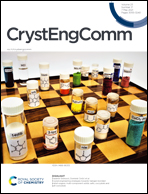One-dimensional and two-dimensional coordination polymers from cluster modular construction†
Abstract
The treatment of the metal sulfide precursor [Et4N][Tp*WS3] (Tp* = hydridotris(3,5-dimethylpyrazol-1-yl)borate) (1) with Cu(I) and the Fe-bipyridine complex ligand L1 in the presence of (NH4)2SO4 produced one-dimensional (1D) [(Tp*WS3Cu2)2(L1)2](BF4)2 (2) and two-dimensional (2D) [(Tp*WS3Cu3)2(L1)3(μ3-SO4)2] (3) heterometallic coordination polymers (CPs). Both CPs were characterized using elemental analysis, IR spectra, UV-vis spectra, mass spectra and single crystal X-ray diffraction. Compound 2 contains a butterfly-shaped core [Tp*WS3Cu2] serving as a two-connecting node to link its equivalent ones viaL1 bridges to form a 1D zigzag chain extending along the c axis. Compound 3 consists of a 2D layer structure with a (6,3) network in which each complete cubane-like core [Tp*WS3Cu3(μ3-SO4)] works as a pyramidal three-connecting node to link its equivalent ones viaL1 bridges. The formation of the different structural topologies of 2 and 3 may be ascribed to the different precursor-to-Cu(I) molar ratios (1 : 2 for 2 and 1 : 3 for 3). The cluster modular construction (CMC) was used to simplify the structural modules of 2 and 3 as straightforward modules to clarify the possible process of assembly and structural characteristics. In addition, the third-order nonlinear optical (NLO) properties of 2 and 3 in MeCN were investigated. They both displayed enhanced third-order NLO responses relative to those of 1 and L1.

- This article is part of the themed collection: Coordination Networks


 Please wait while we load your content...
Please wait while we load your content...